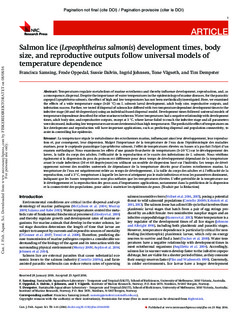| dc.contributor.author | Samsing, Francisca | |
| dc.contributor.author | Oppedal, Frode | |
| dc.contributor.author | Dalvin, Sussie | |
| dc.contributor.author | Johnsen, Ingrid Askeland | |
| dc.contributor.author | Vågseth, Tone | |
| dc.contributor.author | Dempster, Timothy David | |
| dc.date.accessioned | 2016-08-08T11:15:52Z | |
| dc.date.accessioned | 2016-08-09T10:18:50Z | |
| dc.date.available | 2016-08-08T11:15:52Z | |
| dc.date.available | 2016-08-09T10:18:50Z | |
| dc.date.issued | 2016-05-25 | |
| dc.identifier.citation | Canadian Journal of Fisheries and Aquatic Sciences 2016 | nb_NO |
| dc.identifier.issn | 1205-7533 | |
| dc.identifier.uri | http://hdl.handle.net/11250/2398342 | |
| dc.description | - | nb_NO |
| dc.description.abstract | Temperatures regulate metabolism of marine ectotherms and thereby influence development, reproduction, and, as a consequence, dispersal. Despite the importance of water temperatures in the epidemiology of marine diseases, for the parasitic copepod Lepeophtheirus salmonis, the effect of high and low temperatures has not been methodically investigated. Here, we examined the effects of a wide temperature range (3–20 °C) on L. salmonis larval development, adult body size, reproductive outputs, and infestation success. Further, we tested if dispersal of salmon lice differed with two temperature-dependent development times to the infective stage (30 and 60 degree-days) using an individual-based dispersal model. Development times followed universal models of temperature dependence described for other marine ectotherms. Water temperatures had a negative relationship with development times, adult body size, and reproductive outputs, except at 3 °C, where larvae failed to reach the infective stage and all parameters were decreased, indicating low temperatures are more detrimental than high temperatures. The predictable effect of temperatures on lice development and reproduction will have important applications, such as predicting dispersal and population connectivity, to assist in controlling lice epidemics. | nb_NO |
| dc.language.iso | eng | nb_NO |
| dc.publisher | NRC Press | nb_NO |
| dc.rights | Navngivelse 3.0 Norge | * |
| dc.rights.uri | http://creativecommons.org/licenses/by/3.0/no/ | * |
| dc.title | Salmon lice (Lepeophtheirus salmonis) development times, body size and reproductive outputs follow universal models of temperature dependence | nb_NO |
| dc.type | Journal article | nb_NO |
| dc.type | Peer reviewed | nb_NO |
| dc.date.updated | 2016-08-08T11:15:52Z | |
| dc.subject.nsi | VDP::Landbruks- og fiskerifag: 900::Fiskerifag: 920::Fiskehelse : 923 | nb_NO |
| dc.subject.nsi | VDP::Agriculture and fisheries science: 900::Fisheries science: 920::Fish health: 923 | nb_NO |
| dc.subject.nsi | VDP::Matematikk og naturvitenskap: 400::Zoologiske og botaniske fag: 480::Parasittologi: 484 | nb_NO |
| dc.subject.nsi | VDP::Mathematics and natural scienses: 400::Zoology and botany: 480::Parasitology: 484 | nb_NO |
| dc.source.pagenumber | 11 s. | nb_NO |
| dc.source.journal | Canadian Journal of Fisheries and Aquatic Sciences | nb_NO |
| dc.identifier.doi | 10.1139/cjfas-2016-0050 | |
| dc.identifier.cristin | 1358740 | |

